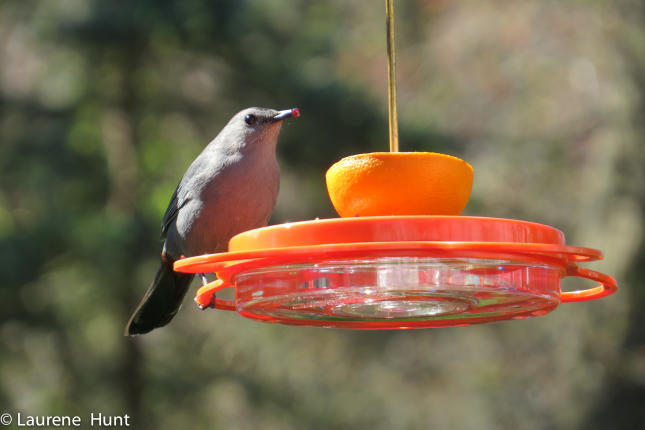
Gray Catbird – The Other Bird with a Sweet Tooth (Beak) for Grape Jelly!
If you have been putting out a feeder with grape jelly in an attempt to attract Baltimore Orioles, you probably have noticed another visitor showing up to feast on the sweet treat…the Gray Catbird. Catbirds are very fond of fruit, so if you grow a garden with grapes, raspberries, blueberries, strawberries, cherries, holly berries or mulberries, they’ll be very fond of you as well…sweet! Just like orioles, catbirds also like suet, Bark Butter® foods, and mealworms. During the summer months, catbirds eat a lot of insects and primarily feed their young a diet of creepy crawlies.
Of course, “Gray” Catbirds aren’t as flashy as the bright orange orioles, but what they lack in dazzling color they more than make up with cheerful personality! In suburban yards and parks, catbirds flit from tree to tree, bush to bush singing their boisterous repertoire of warbling whistles, gurgles, chirps and catlike mew. Like their relatives, the Northern Mockingbird, catbirds also mimic the songs of other birds and animals and weave them into their song, which can be a brief series of notes or a full-blown symphony! Catbird songs have been timed to last as long as 10 minutes while they sing to establish territory and attract mates. It’s the male that engages in these elaborate songs and the female who will sing back more briefly. It is believed that females are attracted to the males with the longest songs because they have successfully survived the most seasons and learned the most notes! To give you some idea of just how incredible their song can be, check out this Cornell Lab of Ornithology video of a catbird mimicking dozens of bird species and even a tree frog! https://www.youtube.com/watch?v=KRgvpjcSNcM
Once the male wows his lady, they choose a piece of real estate (generally in the center of a dense bush) to set up nest building. The female builds the open nest cup from twigs, bark, mud, grasses, animal fur and pine needles. The male will bring nesting material, but rarely helps build the nest. The female will lay and incubate 2-6 eggs and once hatched both parents will feed the young. The pair will raise 2-3 broods in a season.
Catbirds breed throughout much of the United States, although rarely in the most western states, and into southern Canada. Some birds are year-long residents along the Atlantic Coast south of New England and some winter along the Gulf Coast of the U.S. and Mexico, the Caribbean and Central America.
The feeder in the photo is our WBU Oriole Feeder and it was designed to hold grape jelly, nectar and orange halves. Here is a link to this feeder and other feeders that will attract orioles and yes, catbirds https://order.wbu.com/woburn/bird-feeders/oriole-feeders

